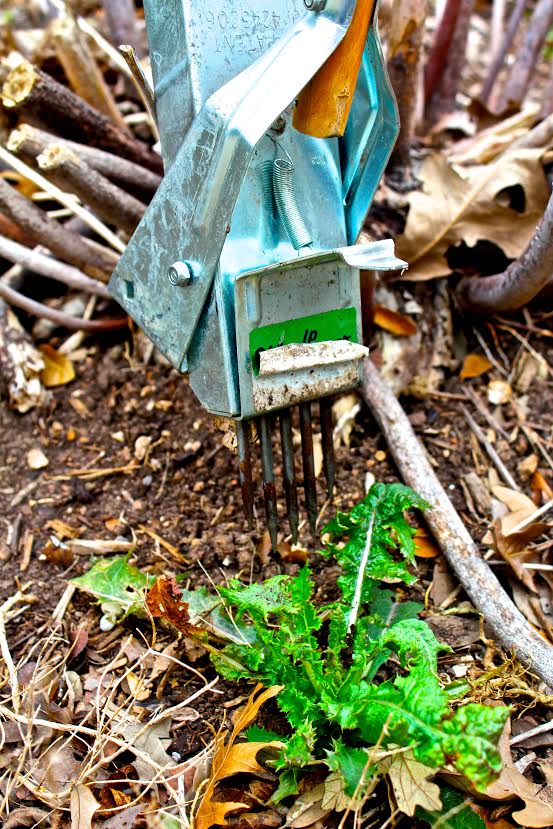

Now that the veil of winter has finally lifted, gardeners eagerly await green growth in the garden. Daily surveys begin – in an attempt to detect tiny buds lining tree limbs or a hint of foliage emerging at ground level from the roots of our hardy perennials.
Not so difficult to find, however, is the burgeoning crop of spring weeds. They’re everywhere. Having spent a cold, quiet winter dormant and lying in wait, they’ve germinated and are spreading like … well, weeds.
What is a weed? One man’s weed is another man’s wildflower, right?
According to Webster’s dictionary, a weed is: “a plant that is not valued where it is growing and is usually of rank growth; esp: one that tends to overgrow or choke out more desirable plants.”
The most obvious method to rid the garden of weeds, is to pull them or to pop them. It’s generally easier to pull them when the soil is moist, so take advantage of our infrequent rains or water the affected area before starting.
There are a variety of tools designed to make this process easier. My favorites are the Garden Weasel weed popper and the CobraHead weeder and cultivator.
The first allows you to remove larger weeds like crabgrass and dandelions while standing up – a big plus for me. The tool has a row of sharp tines. Using your foot on a pedal, you push the tines into the soil at the edge of the weed and then push down on the pedal and the weed literally pops up out of the ground.
The CobraHead weeder enables you to whack at the weedy area and loosen the soil like a short hoe, and drag it toward you to pull it out of the ground.
If pulling isn’t your passion, there are several other safe and proven methods you can try to remove your weeds without dangerous herbicides that pollute our groundwater.
Corn gluten is an excellent pre-emergent that prevents weed seeds from sprouting or kills them right after they germinate. Only use corn gluten near shrubs and perennials or on lawns. Do not allow it to come in contact with areas where you intend to sow seeds. The corn gluten should be spread before the emergence of weeds in early spring and fall.
One of the simplest approaches, if your weeds are somewhat isolated from desired plants, is to pour good old boiling water on them. But be careful, as this method will kill anything else in its path. Make sure it doesn’t run over to something you’ve been working hard to grow.
You can also apply the same method with bleach – putting it in a small sprayer and using the concentrated nozzle to gently spray specific weeds.
Some gardeners also use vinegar in this manner. But grocery store vinegar is only 5 percent acetic acid and won’t work. To use this method, you would need to use a vinegar that is 20 percent acetic, which is not available in grocery stores. However, at this strength, the vinegar can cause skin, eye, ear, nose and throat irritation. Goggles should be work to apply it. And it may not kill the roots, just the foliage, which really isn’t very helpful if you want to eradicate the weeds.
Some serious gardeners have also taken to using a small propane torch, like that used to caramelize the top of delicious creme brulee. Torching weeds make be fun, but again, it doesn’t necessarily get at the roots. This method would work best on annual weeds, but is not recommended for use around mulch, bark or pine straw. Given our drought, winds and periodic burn bans, this method should really only be considered only in areas with rock, concrete or pavers to avoid any possibility of fire.
For those with a wide area of weeds, smothering them is another option. Layer newspaper (at least 4 sheets thick) or cardboard over the offending area for a while. The length of time will depend on the weeds and the time of year, but they will eventually die from lack of sun. Be sure to leave the layers on long enough to ensure that other weed seeds aren’t sprouting as well.
And, finally, my favorite way to deal with weeds is to simply hide them or choke them out with beautiful plants. In the competition for sunlight, water and nutrients, a garden thick with ground covers, low-growing perennials or flowers can overwhelm weeds.
Whichever method you use, the best approach is to keep after them on a regular basis, so they don’t get out of hand.
Local Landscape Designer and Garden Coach Diana Kirby provides landscaping tips at http:/www.dianasdesignsaustin.com and writes a garden blog at https://www.dianasdesignsaustin.com

